Reflective Paper on Design Thinking
VerifiedAdded on 2023/03/30
|20
|3064
|332
AI Summary
This reflective paper discusses the process of design thinking and its application in organizations. It provides insights on weekly learnings and personal development. The paper covers topics such as the importance of design thinking, the significance of values, and the stages of the design process. It also includes a personal development plan and an action plan for the future.
Contribute Materials
Your contribution can guide someone’s learning journey. Share your
documents today.
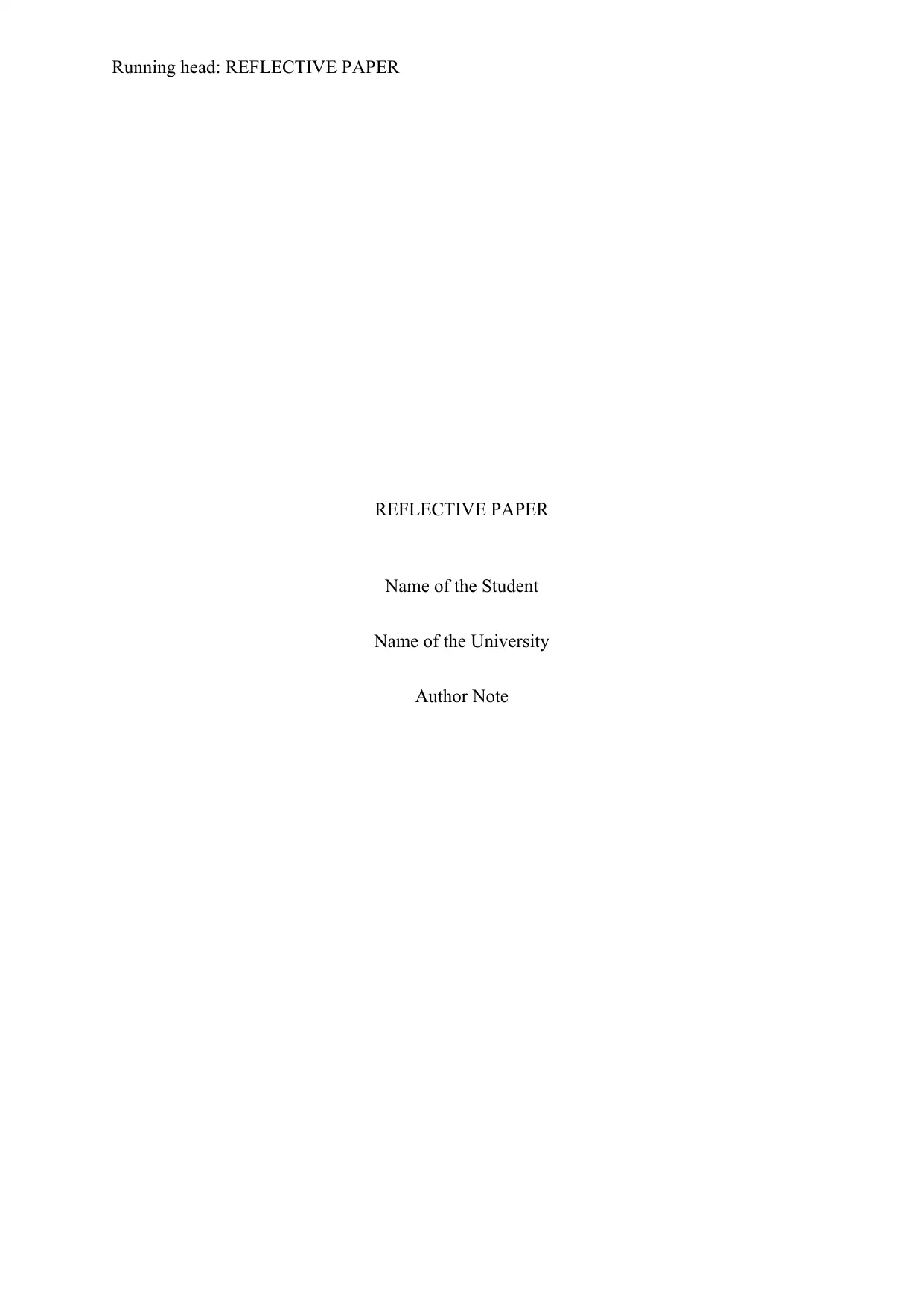
Running head: REFLECTIVE PAPER
REFLECTIVE PAPER
Name of the Student
Name of the University
Author Note
REFLECTIVE PAPER
Name of the Student
Name of the University
Author Note
Secure Best Marks with AI Grader
Need help grading? Try our AI Grader for instant feedback on your assignments.
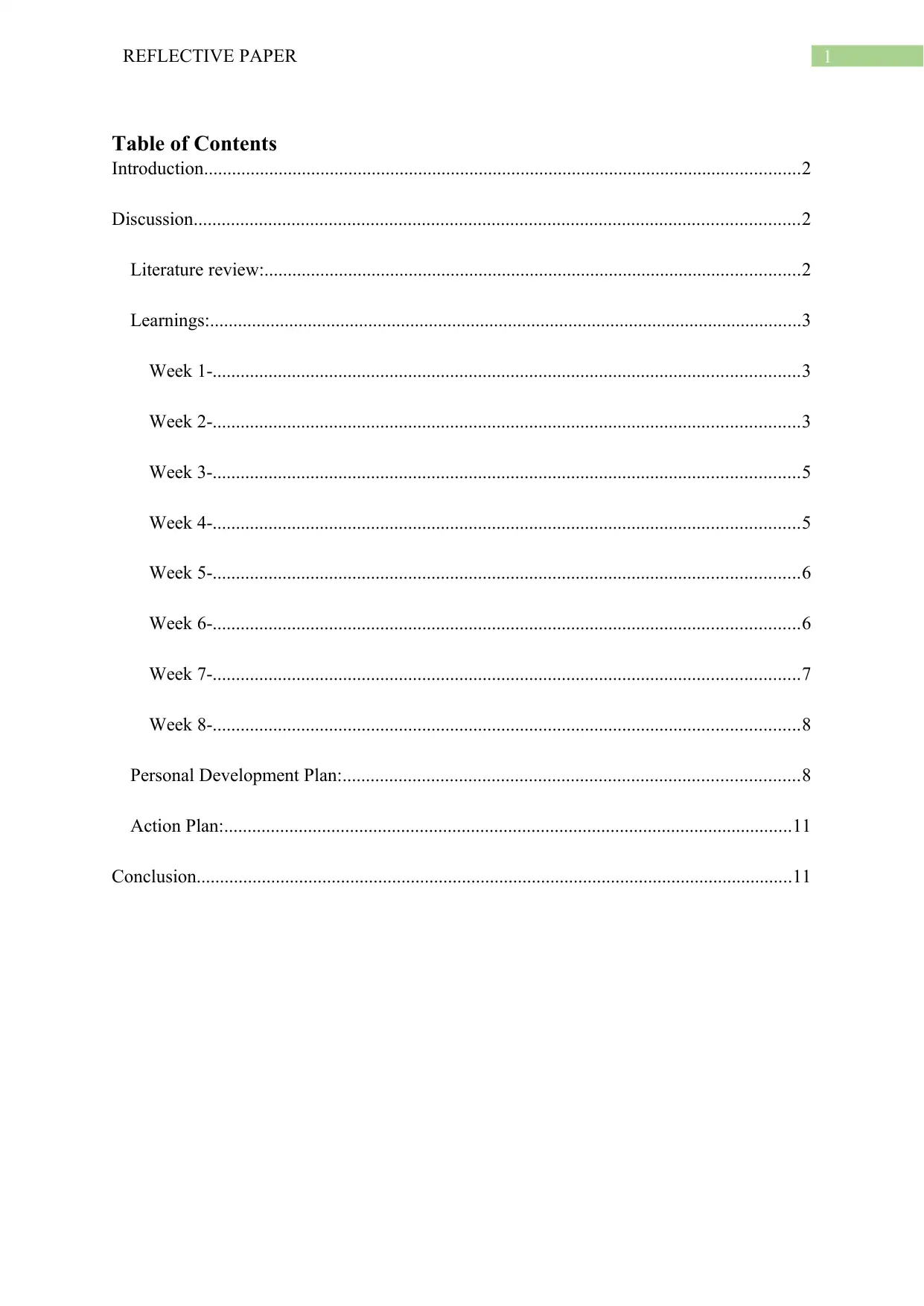
1REFLECTIVE PAPER
Table of Contents
Introduction................................................................................................................................2
Discussion..................................................................................................................................2
Literature review:...................................................................................................................2
Learnings:...............................................................................................................................3
Week 1-..............................................................................................................................3
Week 2-..............................................................................................................................3
Week 3-..............................................................................................................................5
Week 4-..............................................................................................................................5
Week 5-..............................................................................................................................6
Week 6-..............................................................................................................................6
Week 7-..............................................................................................................................7
Week 8-..............................................................................................................................8
Personal Development Plan:..................................................................................................8
Action Plan:..........................................................................................................................11
Conclusion................................................................................................................................11
Table of Contents
Introduction................................................................................................................................2
Discussion..................................................................................................................................2
Literature review:...................................................................................................................2
Learnings:...............................................................................................................................3
Week 1-..............................................................................................................................3
Week 2-..............................................................................................................................3
Week 3-..............................................................................................................................5
Week 4-..............................................................................................................................5
Week 5-..............................................................................................................................6
Week 6-..............................................................................................................................6
Week 7-..............................................................................................................................7
Week 8-..............................................................................................................................8
Personal Development Plan:..................................................................................................8
Action Plan:..........................................................................................................................11
Conclusion................................................................................................................................11
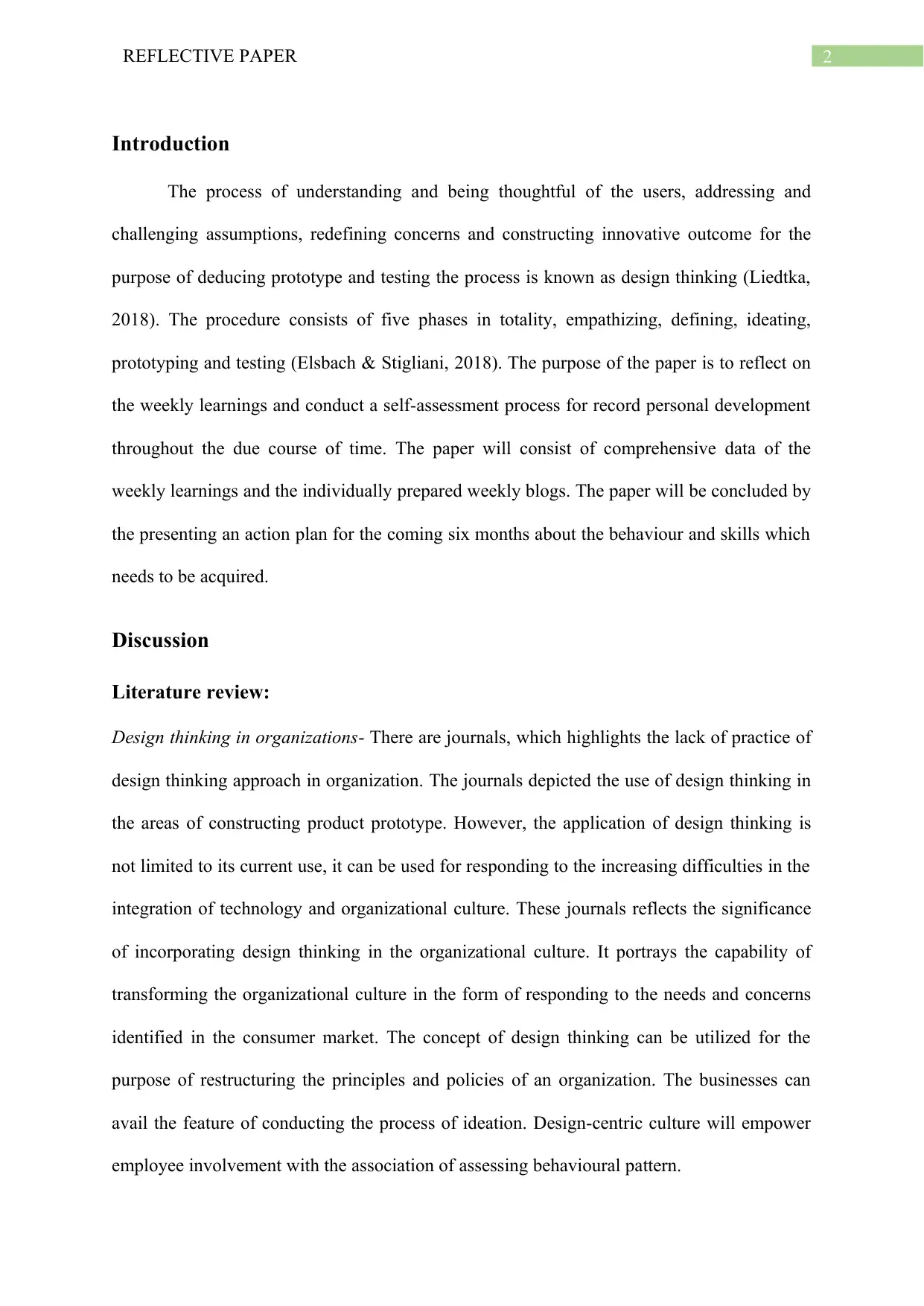
2REFLECTIVE PAPER
Introduction
The process of understanding and being thoughtful of the users, addressing and
challenging assumptions, redefining concerns and constructing innovative outcome for the
purpose of deducing prototype and testing the process is known as design thinking (Liedtka,
2018). The procedure consists of five phases in totality, empathizing, defining, ideating,
prototyping and testing (Elsbach & Stigliani, 2018). The purpose of the paper is to reflect on
the weekly learnings and conduct a self-assessment process for record personal development
throughout the due course of time. The paper will consist of comprehensive data of the
weekly learnings and the individually prepared weekly blogs. The paper will be concluded by
the presenting an action plan for the coming six months about the behaviour and skills which
needs to be acquired.
Discussion
Literature review:
Design thinking in organizations- There are journals, which highlights the lack of practice of
design thinking approach in organization. The journals depicted the use of design thinking in
the areas of constructing product prototype. However, the application of design thinking is
not limited to its current use, it can be used for responding to the increasing difficulties in the
integration of technology and organizational culture. These journals reflects the significance
of incorporating design thinking in the organizational culture. It portrays the capability of
transforming the organizational culture in the form of responding to the needs and concerns
identified in the consumer market. The concept of design thinking can be utilized for the
purpose of restructuring the principles and policies of an organization. The businesses can
avail the feature of conducting the process of ideation. Design-centric culture will empower
employee involvement with the association of assessing behavioural pattern.
Introduction
The process of understanding and being thoughtful of the users, addressing and
challenging assumptions, redefining concerns and constructing innovative outcome for the
purpose of deducing prototype and testing the process is known as design thinking (Liedtka,
2018). The procedure consists of five phases in totality, empathizing, defining, ideating,
prototyping and testing (Elsbach & Stigliani, 2018). The purpose of the paper is to reflect on
the weekly learnings and conduct a self-assessment process for record personal development
throughout the due course of time. The paper will consist of comprehensive data of the
weekly learnings and the individually prepared weekly blogs. The paper will be concluded by
the presenting an action plan for the coming six months about the behaviour and skills which
needs to be acquired.
Discussion
Literature review:
Design thinking in organizations- There are journals, which highlights the lack of practice of
design thinking approach in organization. The journals depicted the use of design thinking in
the areas of constructing product prototype. However, the application of design thinking is
not limited to its current use, it can be used for responding to the increasing difficulties in the
integration of technology and organizational culture. These journals reflects the significance
of incorporating design thinking in the organizational culture. It portrays the capability of
transforming the organizational culture in the form of responding to the needs and concerns
identified in the consumer market. The concept of design thinking can be utilized for the
purpose of restructuring the principles and policies of an organization. The businesses can
avail the feature of conducting the process of ideation. Design-centric culture will empower
employee involvement with the association of assessing behavioural pattern.
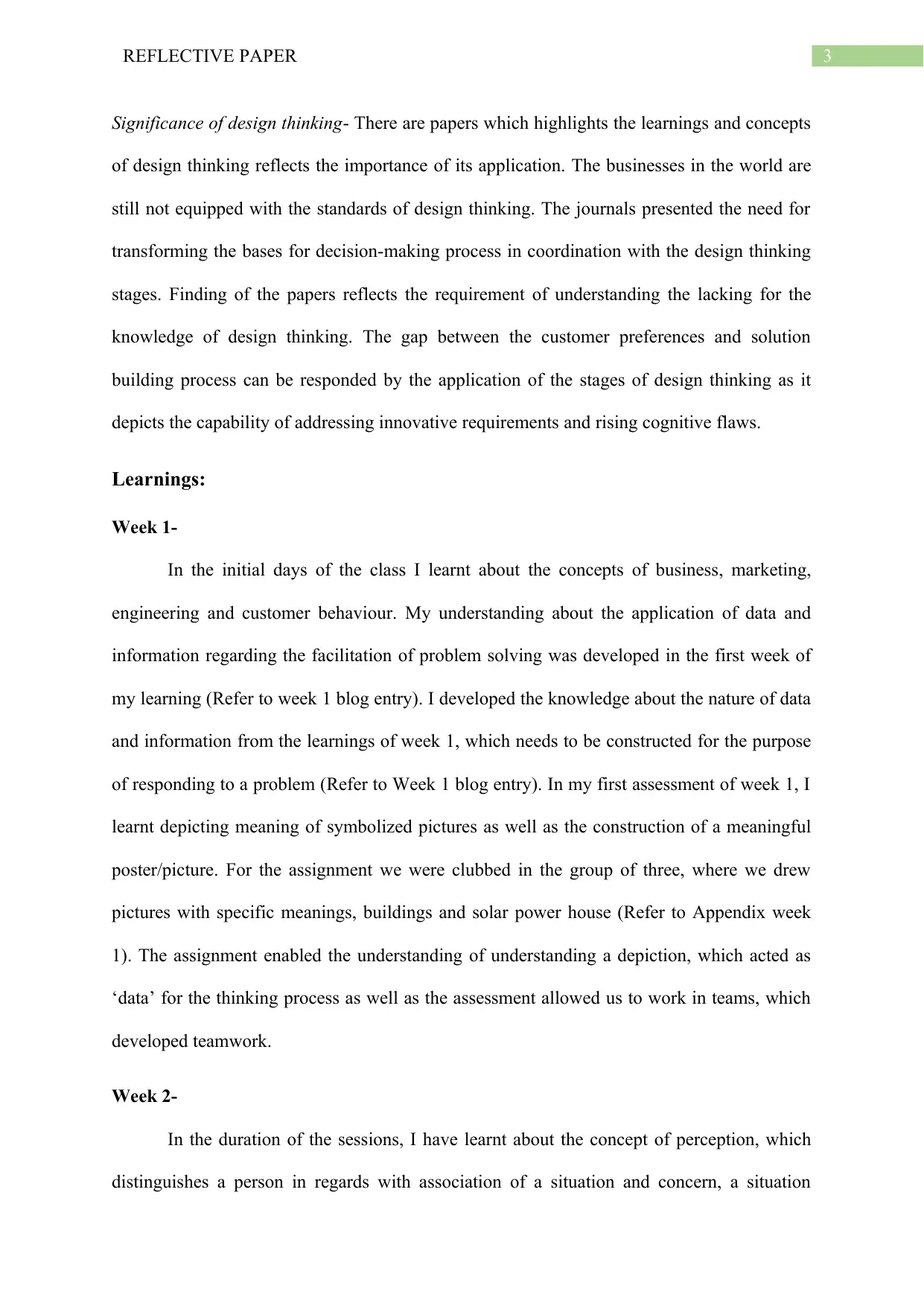
3REFLECTIVE PAPER
Significance of design thinking- There are papers which highlights the learnings and concepts
of design thinking reflects the importance of its application. The businesses in the world are
still not equipped with the standards of design thinking. The journals presented the need for
transforming the bases for decision-making process in coordination with the design thinking
stages. Finding of the papers reflects the requirement of understanding the lacking for the
knowledge of design thinking. The gap between the customer preferences and solution
building process can be responded by the application of the stages of design thinking as it
depicts the capability of addressing innovative requirements and rising cognitive flaws.
Learnings:
Week 1-
In the initial days of the class I learnt about the concepts of business, marketing,
engineering and customer behaviour. My understanding about the application of data and
information regarding the facilitation of problem solving was developed in the first week of
my learning (Refer to week 1 blog entry). I developed the knowledge about the nature of data
and information from the learnings of week 1, which needs to be constructed for the purpose
of responding to a problem (Refer to Week 1 blog entry). In my first assessment of week 1, I
learnt depicting meaning of symbolized pictures as well as the construction of a meaningful
poster/picture. For the assignment we were clubbed in the group of three, where we drew
pictures with specific meanings, buildings and solar power house (Refer to Appendix week
1). The assignment enabled the understanding of understanding a depiction, which acted as
‘data’ for the thinking process as well as the assessment allowed us to work in teams, which
developed teamwork.
Week 2-
In the duration of the sessions, I have learnt about the concept of perception, which
distinguishes a person in regards with association of a situation and concern, a situation
Significance of design thinking- There are papers which highlights the learnings and concepts
of design thinking reflects the importance of its application. The businesses in the world are
still not equipped with the standards of design thinking. The journals presented the need for
transforming the bases for decision-making process in coordination with the design thinking
stages. Finding of the papers reflects the requirement of understanding the lacking for the
knowledge of design thinking. The gap between the customer preferences and solution
building process can be responded by the application of the stages of design thinking as it
depicts the capability of addressing innovative requirements and rising cognitive flaws.
Learnings:
Week 1-
In the initial days of the class I learnt about the concepts of business, marketing,
engineering and customer behaviour. My understanding about the application of data and
information regarding the facilitation of problem solving was developed in the first week of
my learning (Refer to week 1 blog entry). I developed the knowledge about the nature of data
and information from the learnings of week 1, which needs to be constructed for the purpose
of responding to a problem (Refer to Week 1 blog entry). In my first assessment of week 1, I
learnt depicting meaning of symbolized pictures as well as the construction of a meaningful
poster/picture. For the assignment we were clubbed in the group of three, where we drew
pictures with specific meanings, buildings and solar power house (Refer to Appendix week
1). The assignment enabled the understanding of understanding a depiction, which acted as
‘data’ for the thinking process as well as the assessment allowed us to work in teams, which
developed teamwork.
Week 2-
In the duration of the sessions, I have learnt about the concept of perception, which
distinguishes a person in regards with association of a situation and concern, a situation
Secure Best Marks with AI Grader
Need help grading? Try our AI Grader for instant feedback on your assignments.
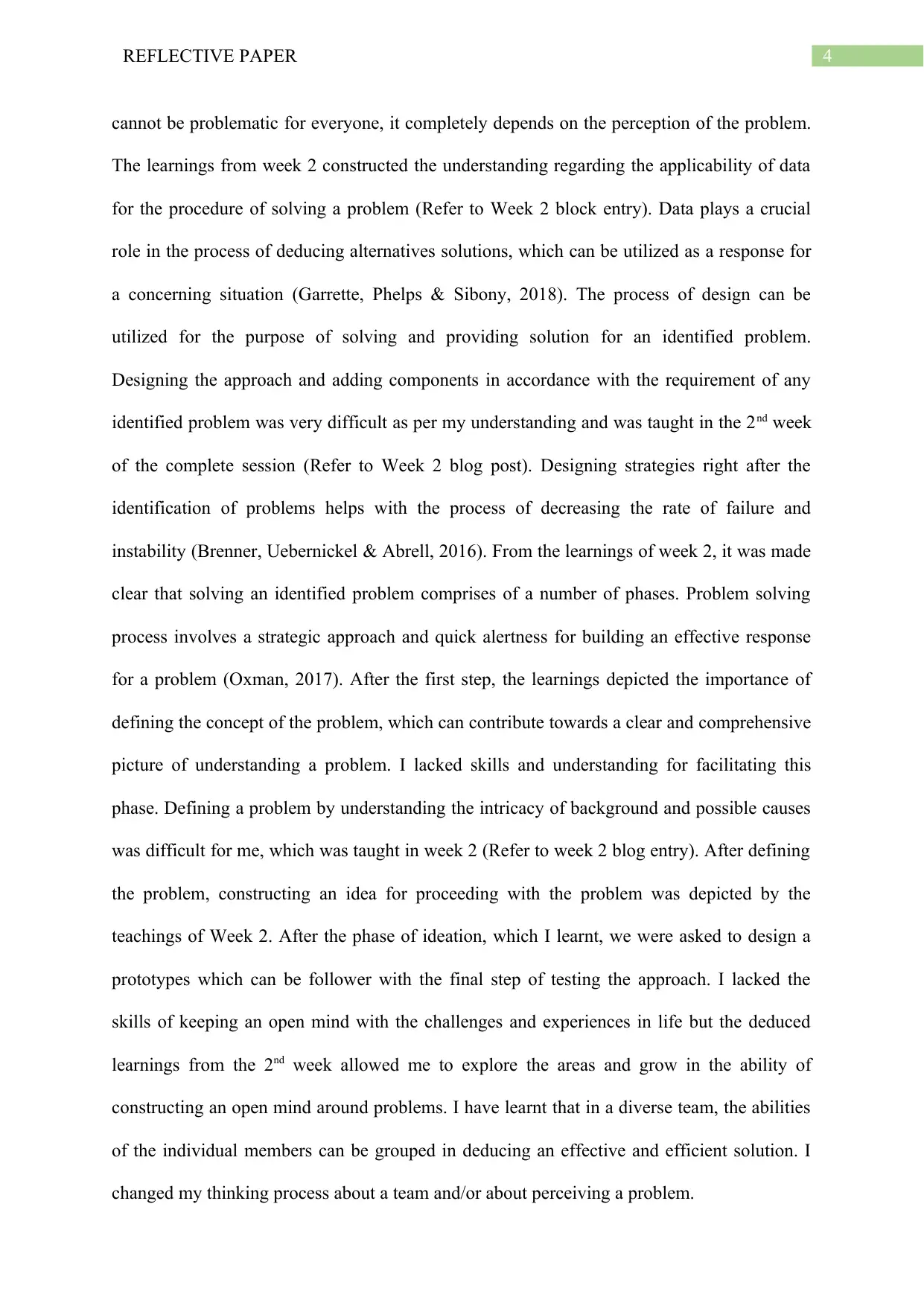
4REFLECTIVE PAPER
cannot be problematic for everyone, it completely depends on the perception of the problem.
The learnings from week 2 constructed the understanding regarding the applicability of data
for the procedure of solving a problem (Refer to Week 2 block entry). Data plays a crucial
role in the process of deducing alternatives solutions, which can be utilized as a response for
a concerning situation (Garrette, Phelps & Sibony, 2018). The process of design can be
utilized for the purpose of solving and providing solution for an identified problem.
Designing the approach and adding components in accordance with the requirement of any
identified problem was very difficult as per my understanding and was taught in the 2nd week
of the complete session (Refer to Week 2 blog post). Designing strategies right after the
identification of problems helps with the process of decreasing the rate of failure and
instability (Brenner, Uebernickel & Abrell, 2016). From the learnings of week 2, it was made
clear that solving an identified problem comprises of a number of phases. Problem solving
process involves a strategic approach and quick alertness for building an effective response
for a problem (Oxman, 2017). After the first step, the learnings depicted the importance of
defining the concept of the problem, which can contribute towards a clear and comprehensive
picture of understanding a problem. I lacked skills and understanding for facilitating this
phase. Defining a problem by understanding the intricacy of background and possible causes
was difficult for me, which was taught in week 2 (Refer to week 2 blog entry). After defining
the problem, constructing an idea for proceeding with the problem was depicted by the
teachings of Week 2. After the phase of ideation, which I learnt, we were asked to design a
prototypes which can be follower with the final step of testing the approach. I lacked the
skills of keeping an open mind with the challenges and experiences in life but the deduced
learnings from the 2nd week allowed me to explore the areas and grow in the ability of
constructing an open mind around problems. I have learnt that in a diverse team, the abilities
of the individual members can be grouped in deducing an effective and efficient solution. I
changed my thinking process about a team and/or about perceiving a problem.
cannot be problematic for everyone, it completely depends on the perception of the problem.
The learnings from week 2 constructed the understanding regarding the applicability of data
for the procedure of solving a problem (Refer to Week 2 block entry). Data plays a crucial
role in the process of deducing alternatives solutions, which can be utilized as a response for
a concerning situation (Garrette, Phelps & Sibony, 2018). The process of design can be
utilized for the purpose of solving and providing solution for an identified problem.
Designing the approach and adding components in accordance with the requirement of any
identified problem was very difficult as per my understanding and was taught in the 2nd week
of the complete session (Refer to Week 2 blog post). Designing strategies right after the
identification of problems helps with the process of decreasing the rate of failure and
instability (Brenner, Uebernickel & Abrell, 2016). From the learnings of week 2, it was made
clear that solving an identified problem comprises of a number of phases. Problem solving
process involves a strategic approach and quick alertness for building an effective response
for a problem (Oxman, 2017). After the first step, the learnings depicted the importance of
defining the concept of the problem, which can contribute towards a clear and comprehensive
picture of understanding a problem. I lacked skills and understanding for facilitating this
phase. Defining a problem by understanding the intricacy of background and possible causes
was difficult for me, which was taught in week 2 (Refer to week 2 blog entry). After defining
the problem, constructing an idea for proceeding with the problem was depicted by the
teachings of Week 2. After the phase of ideation, which I learnt, we were asked to design a
prototypes which can be follower with the final step of testing the approach. I lacked the
skills of keeping an open mind with the challenges and experiences in life but the deduced
learnings from the 2nd week allowed me to explore the areas and grow in the ability of
constructing an open mind around problems. I have learnt that in a diverse team, the abilities
of the individual members can be grouped in deducing an effective and efficient solution. I
changed my thinking process about a team and/or about perceiving a problem.
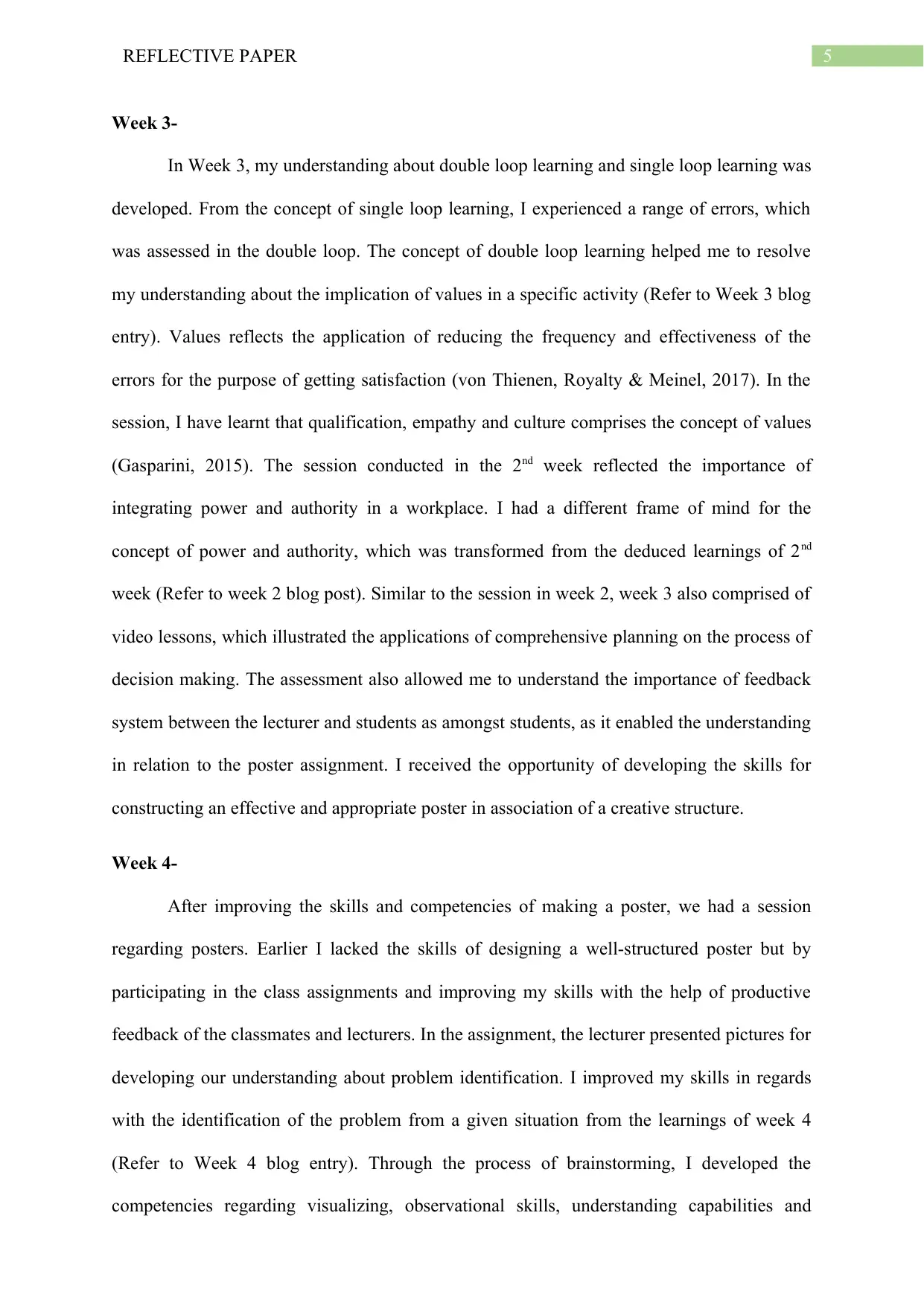
5REFLECTIVE PAPER
Week 3-
In Week 3, my understanding about double loop learning and single loop learning was
developed. From the concept of single loop learning, I experienced a range of errors, which
was assessed in the double loop. The concept of double loop learning helped me to resolve
my understanding about the implication of values in a specific activity (Refer to Week 3 blog
entry). Values reflects the application of reducing the frequency and effectiveness of the
errors for the purpose of getting satisfaction (von Thienen, Royalty & Meinel, 2017). In the
session, I have learnt that qualification, empathy and culture comprises the concept of values
(Gasparini, 2015). The session conducted in the 2nd week reflected the importance of
integrating power and authority in a workplace. I had a different frame of mind for the
concept of power and authority, which was transformed from the deduced learnings of 2nd
week (Refer to week 2 blog post). Similar to the session in week 2, week 3 also comprised of
video lessons, which illustrated the applications of comprehensive planning on the process of
decision making. The assessment also allowed me to understand the importance of feedback
system between the lecturer and students as amongst students, as it enabled the understanding
in relation to the poster assignment. I received the opportunity of developing the skills for
constructing an effective and appropriate poster in association of a creative structure.
Week 4-
After improving the skills and competencies of making a poster, we had a session
regarding posters. Earlier I lacked the skills of designing a well-structured poster but by
participating in the class assignments and improving my skills with the help of productive
feedback of the classmates and lecturers. In the assignment, the lecturer presented pictures for
developing our understanding about problem identification. I improved my skills in regards
with the identification of the problem from a given situation from the learnings of week 4
(Refer to Week 4 blog entry). Through the process of brainstorming, I developed the
competencies regarding visualizing, observational skills, understanding capabilities and
Week 3-
In Week 3, my understanding about double loop learning and single loop learning was
developed. From the concept of single loop learning, I experienced a range of errors, which
was assessed in the double loop. The concept of double loop learning helped me to resolve
my understanding about the implication of values in a specific activity (Refer to Week 3 blog
entry). Values reflects the application of reducing the frequency and effectiveness of the
errors for the purpose of getting satisfaction (von Thienen, Royalty & Meinel, 2017). In the
session, I have learnt that qualification, empathy and culture comprises the concept of values
(Gasparini, 2015). The session conducted in the 2nd week reflected the importance of
integrating power and authority in a workplace. I had a different frame of mind for the
concept of power and authority, which was transformed from the deduced learnings of 2nd
week (Refer to week 2 blog post). Similar to the session in week 2, week 3 also comprised of
video lessons, which illustrated the applications of comprehensive planning on the process of
decision making. The assessment also allowed me to understand the importance of feedback
system between the lecturer and students as amongst students, as it enabled the understanding
in relation to the poster assignment. I received the opportunity of developing the skills for
constructing an effective and appropriate poster in association of a creative structure.
Week 4-
After improving the skills and competencies of making a poster, we had a session
regarding posters. Earlier I lacked the skills of designing a well-structured poster but by
participating in the class assignments and improving my skills with the help of productive
feedback of the classmates and lecturers. In the assignment, the lecturer presented pictures for
developing our understanding about problem identification. I improved my skills in regards
with the identification of the problem from a given situation from the learnings of week 4
(Refer to Week 4 blog entry). Through the process of brainstorming, I developed the
competencies regarding visualizing, observational skills, understanding capabilities and
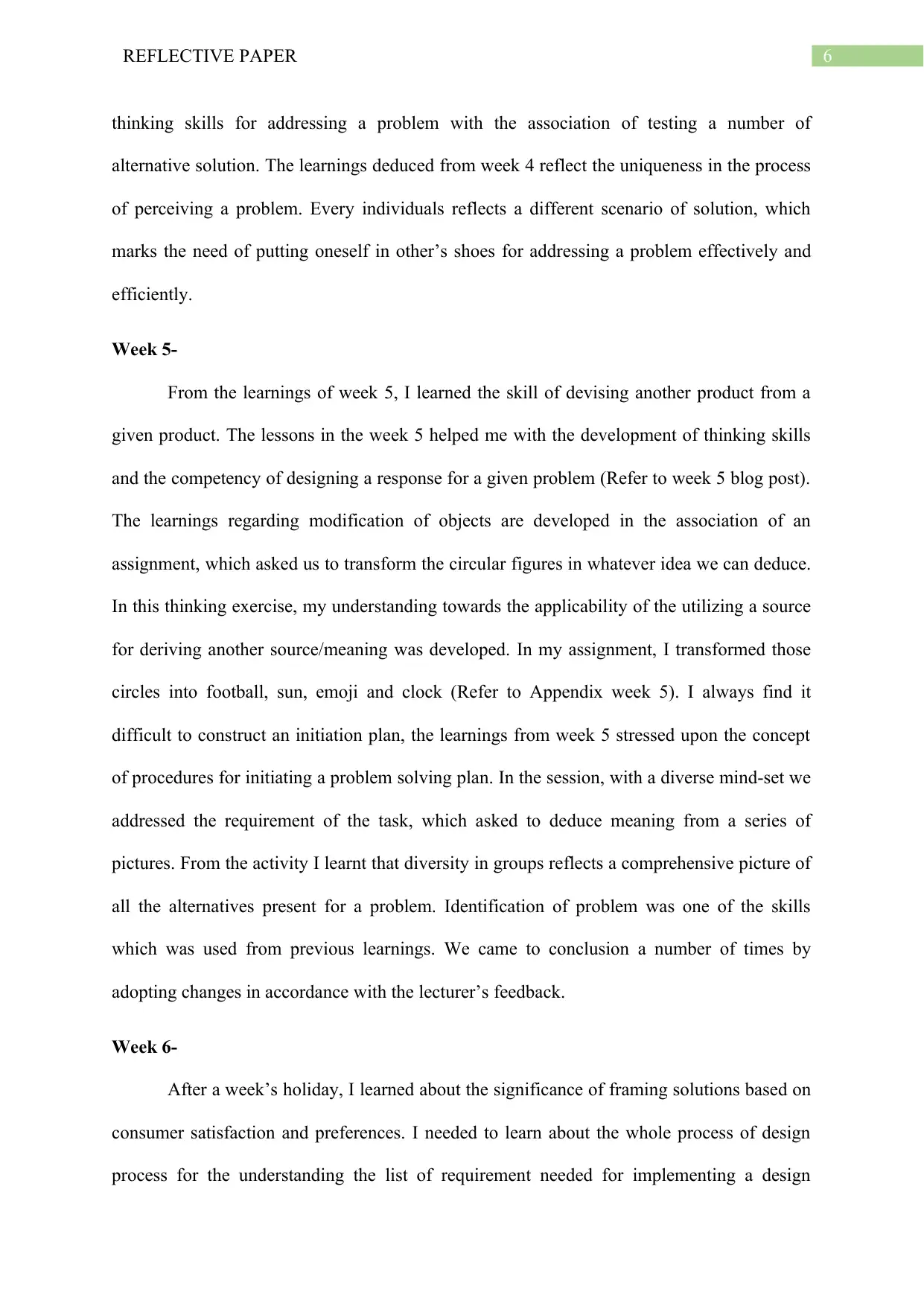
6REFLECTIVE PAPER
thinking skills for addressing a problem with the association of testing a number of
alternative solution. The learnings deduced from week 4 reflect the uniqueness in the process
of perceiving a problem. Every individuals reflects a different scenario of solution, which
marks the need of putting oneself in other’s shoes for addressing a problem effectively and
efficiently.
Week 5-
From the learnings of week 5, I learned the skill of devising another product from a
given product. The lessons in the week 5 helped me with the development of thinking skills
and the competency of designing a response for a given problem (Refer to week 5 blog post).
The learnings regarding modification of objects are developed in the association of an
assignment, which asked us to transform the circular figures in whatever idea we can deduce.
In this thinking exercise, my understanding towards the applicability of the utilizing a source
for deriving another source/meaning was developed. In my assignment, I transformed those
circles into football, sun, emoji and clock (Refer to Appendix week 5). I always find it
difficult to construct an initiation plan, the learnings from week 5 stressed upon the concept
of procedures for initiating a problem solving plan. In the session, with a diverse mind-set we
addressed the requirement of the task, which asked to deduce meaning from a series of
pictures. From the activity I learnt that diversity in groups reflects a comprehensive picture of
all the alternatives present for a problem. Identification of problem was one of the skills
which was used from previous learnings. We came to conclusion a number of times by
adopting changes in accordance with the lecturer’s feedback.
Week 6-
After a week’s holiday, I learned about the significance of framing solutions based on
consumer satisfaction and preferences. I needed to learn about the whole process of design
process for the understanding the list of requirement needed for implementing a design
thinking skills for addressing a problem with the association of testing a number of
alternative solution. The learnings deduced from week 4 reflect the uniqueness in the process
of perceiving a problem. Every individuals reflects a different scenario of solution, which
marks the need of putting oneself in other’s shoes for addressing a problem effectively and
efficiently.
Week 5-
From the learnings of week 5, I learned the skill of devising another product from a
given product. The lessons in the week 5 helped me with the development of thinking skills
and the competency of designing a response for a given problem (Refer to week 5 blog post).
The learnings regarding modification of objects are developed in the association of an
assignment, which asked us to transform the circular figures in whatever idea we can deduce.
In this thinking exercise, my understanding towards the applicability of the utilizing a source
for deriving another source/meaning was developed. In my assignment, I transformed those
circles into football, sun, emoji and clock (Refer to Appendix week 5). I always find it
difficult to construct an initiation plan, the learnings from week 5 stressed upon the concept
of procedures for initiating a problem solving plan. In the session, with a diverse mind-set we
addressed the requirement of the task, which asked to deduce meaning from a series of
pictures. From the activity I learnt that diversity in groups reflects a comprehensive picture of
all the alternatives present for a problem. Identification of problem was one of the skills
which was used from previous learnings. We came to conclusion a number of times by
adopting changes in accordance with the lecturer’s feedback.
Week 6-
After a week’s holiday, I learned about the significance of framing solutions based on
consumer satisfaction and preferences. I needed to learn about the whole process of design
process for the understanding the list of requirement needed for implementing a design
Paraphrase This Document
Need a fresh take? Get an instant paraphrase of this document with our AI Paraphraser
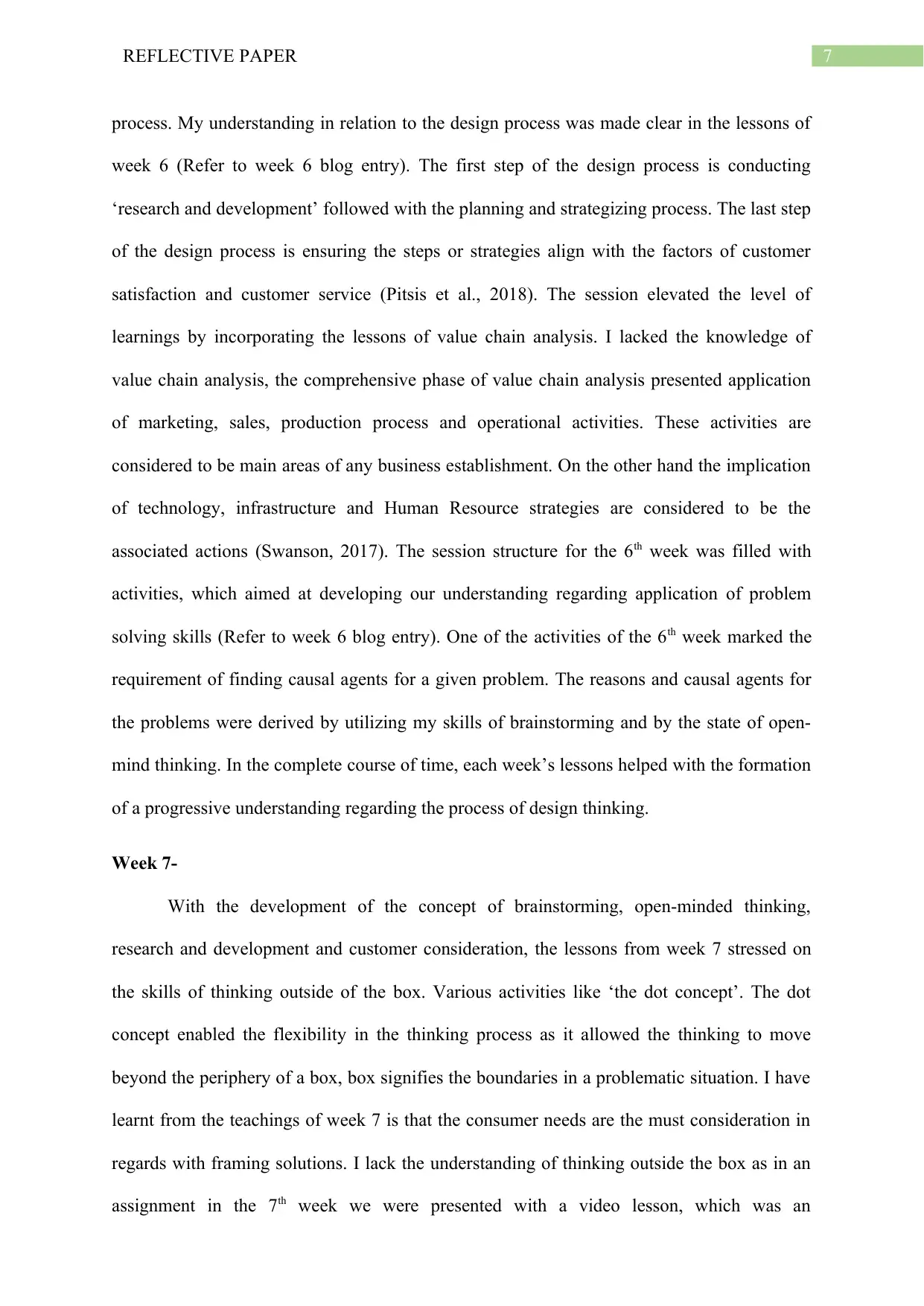
7REFLECTIVE PAPER
process. My understanding in relation to the design process was made clear in the lessons of
week 6 (Refer to week 6 blog entry). The first step of the design process is conducting
‘research and development’ followed with the planning and strategizing process. The last step
of the design process is ensuring the steps or strategies align with the factors of customer
satisfaction and customer service (Pitsis et al., 2018). The session elevated the level of
learnings by incorporating the lessons of value chain analysis. I lacked the knowledge of
value chain analysis, the comprehensive phase of value chain analysis presented application
of marketing, sales, production process and operational activities. These activities are
considered to be main areas of any business establishment. On the other hand the implication
of technology, infrastructure and Human Resource strategies are considered to be the
associated actions (Swanson, 2017). The session structure for the 6th week was filled with
activities, which aimed at developing our understanding regarding application of problem
solving skills (Refer to week 6 blog entry). One of the activities of the 6th week marked the
requirement of finding causal agents for a given problem. The reasons and causal agents for
the problems were derived by utilizing my skills of brainstorming and by the state of open-
mind thinking. In the complete course of time, each week’s lessons helped with the formation
of a progressive understanding regarding the process of design thinking.
Week 7-
With the development of the concept of brainstorming, open-minded thinking,
research and development and customer consideration, the lessons from week 7 stressed on
the skills of thinking outside of the box. Various activities like ‘the dot concept’. The dot
concept enabled the flexibility in the thinking process as it allowed the thinking to move
beyond the periphery of a box, box signifies the boundaries in a problematic situation. I have
learnt from the teachings of week 7 is that the consumer needs are the must consideration in
regards with framing solutions. I lack the understanding of thinking outside the box as in an
assignment in the 7th week we were presented with a video lesson, which was an
process. My understanding in relation to the design process was made clear in the lessons of
week 6 (Refer to week 6 blog entry). The first step of the design process is conducting
‘research and development’ followed with the planning and strategizing process. The last step
of the design process is ensuring the steps or strategies align with the factors of customer
satisfaction and customer service (Pitsis et al., 2018). The session elevated the level of
learnings by incorporating the lessons of value chain analysis. I lacked the knowledge of
value chain analysis, the comprehensive phase of value chain analysis presented application
of marketing, sales, production process and operational activities. These activities are
considered to be main areas of any business establishment. On the other hand the implication
of technology, infrastructure and Human Resource strategies are considered to be the
associated actions (Swanson, 2017). The session structure for the 6th week was filled with
activities, which aimed at developing our understanding regarding application of problem
solving skills (Refer to week 6 blog entry). One of the activities of the 6th week marked the
requirement of finding causal agents for a given problem. The reasons and causal agents for
the problems were derived by utilizing my skills of brainstorming and by the state of open-
mind thinking. In the complete course of time, each week’s lessons helped with the formation
of a progressive understanding regarding the process of design thinking.
Week 7-
With the development of the concept of brainstorming, open-minded thinking,
research and development and customer consideration, the lessons from week 7 stressed on
the skills of thinking outside of the box. Various activities like ‘the dot concept’. The dot
concept enabled the flexibility in the thinking process as it allowed the thinking to move
beyond the periphery of a box, box signifies the boundaries in a problematic situation. I have
learnt from the teachings of week 7 is that the consumer needs are the must consideration in
regards with framing solutions. I lack the understanding of thinking outside the box as in an
assignment in the 7th week we were presented with a video lesson, which was an
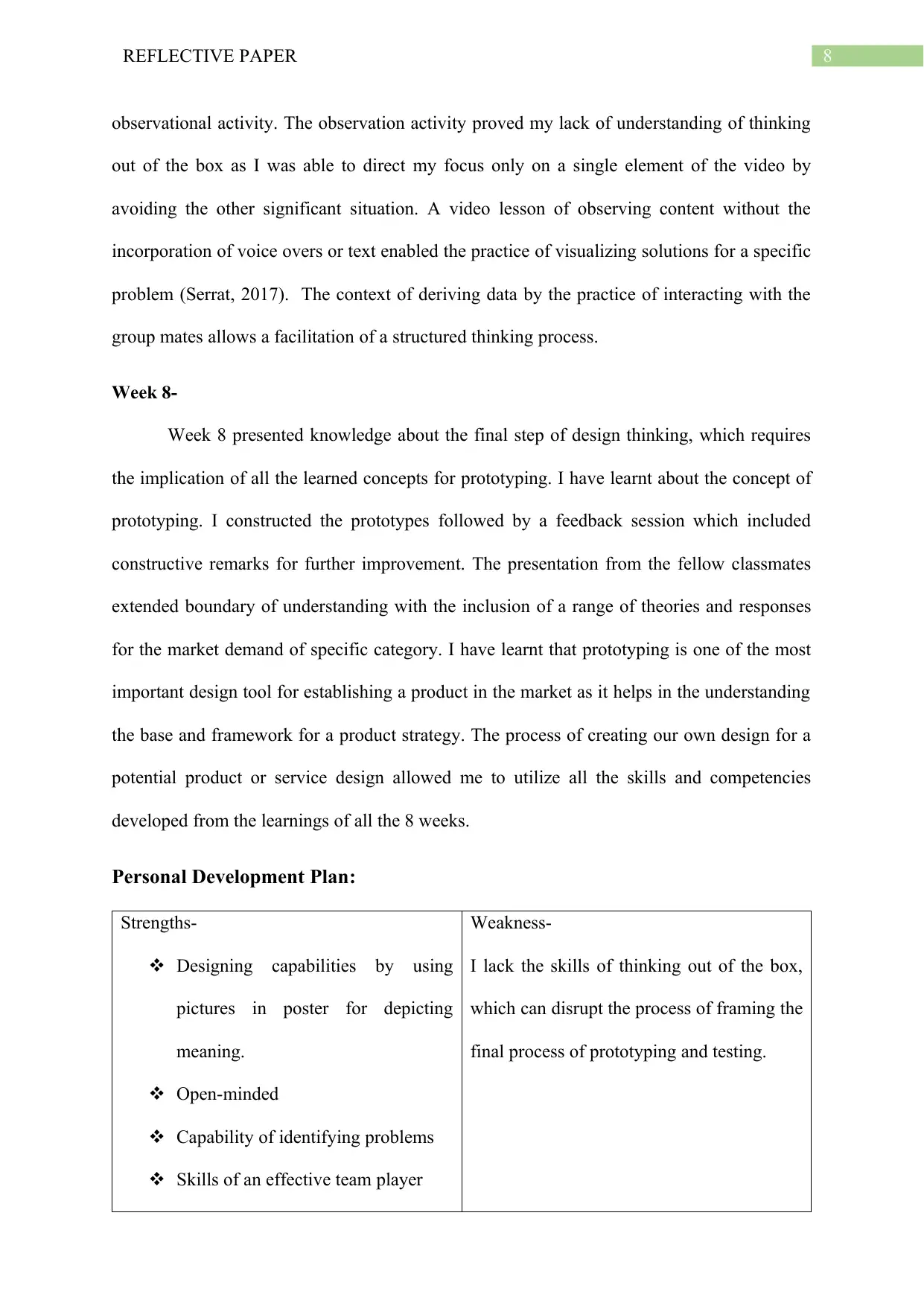
8REFLECTIVE PAPER
observational activity. The observation activity proved my lack of understanding of thinking
out of the box as I was able to direct my focus only on a single element of the video by
avoiding the other significant situation. A video lesson of observing content without the
incorporation of voice overs or text enabled the practice of visualizing solutions for a specific
problem (Serrat, 2017). The context of deriving data by the practice of interacting with the
group mates allows a facilitation of a structured thinking process.
Week 8-
Week 8 presented knowledge about the final step of design thinking, which requires
the implication of all the learned concepts for prototyping. I have learnt about the concept of
prototyping. I constructed the prototypes followed by a feedback session which included
constructive remarks for further improvement. The presentation from the fellow classmates
extended boundary of understanding with the inclusion of a range of theories and responses
for the market demand of specific category. I have learnt that prototyping is one of the most
important design tool for establishing a product in the market as it helps in the understanding
the base and framework for a product strategy. The process of creating our own design for a
potential product or service design allowed me to utilize all the skills and competencies
developed from the learnings of all the 8 weeks.
Personal Development Plan:
Strengths-
Designing capabilities by using
pictures in poster for depicting
meaning.
Open-minded
Capability of identifying problems
Skills of an effective team player
Weakness-
I lack the skills of thinking out of the box,
which can disrupt the process of framing the
final process of prototyping and testing.
observational activity. The observation activity proved my lack of understanding of thinking
out of the box as I was able to direct my focus only on a single element of the video by
avoiding the other significant situation. A video lesson of observing content without the
incorporation of voice overs or text enabled the practice of visualizing solutions for a specific
problem (Serrat, 2017). The context of deriving data by the practice of interacting with the
group mates allows a facilitation of a structured thinking process.
Week 8-
Week 8 presented knowledge about the final step of design thinking, which requires
the implication of all the learned concepts for prototyping. I have learnt about the concept of
prototyping. I constructed the prototypes followed by a feedback session which included
constructive remarks for further improvement. The presentation from the fellow classmates
extended boundary of understanding with the inclusion of a range of theories and responses
for the market demand of specific category. I have learnt that prototyping is one of the most
important design tool for establishing a product in the market as it helps in the understanding
the base and framework for a product strategy. The process of creating our own design for a
potential product or service design allowed me to utilize all the skills and competencies
developed from the learnings of all the 8 weeks.
Personal Development Plan:
Strengths-
Designing capabilities by using
pictures in poster for depicting
meaning.
Open-minded
Capability of identifying problems
Skills of an effective team player
Weakness-
I lack the skills of thinking out of the box,
which can disrupt the process of framing the
final process of prototyping and testing.
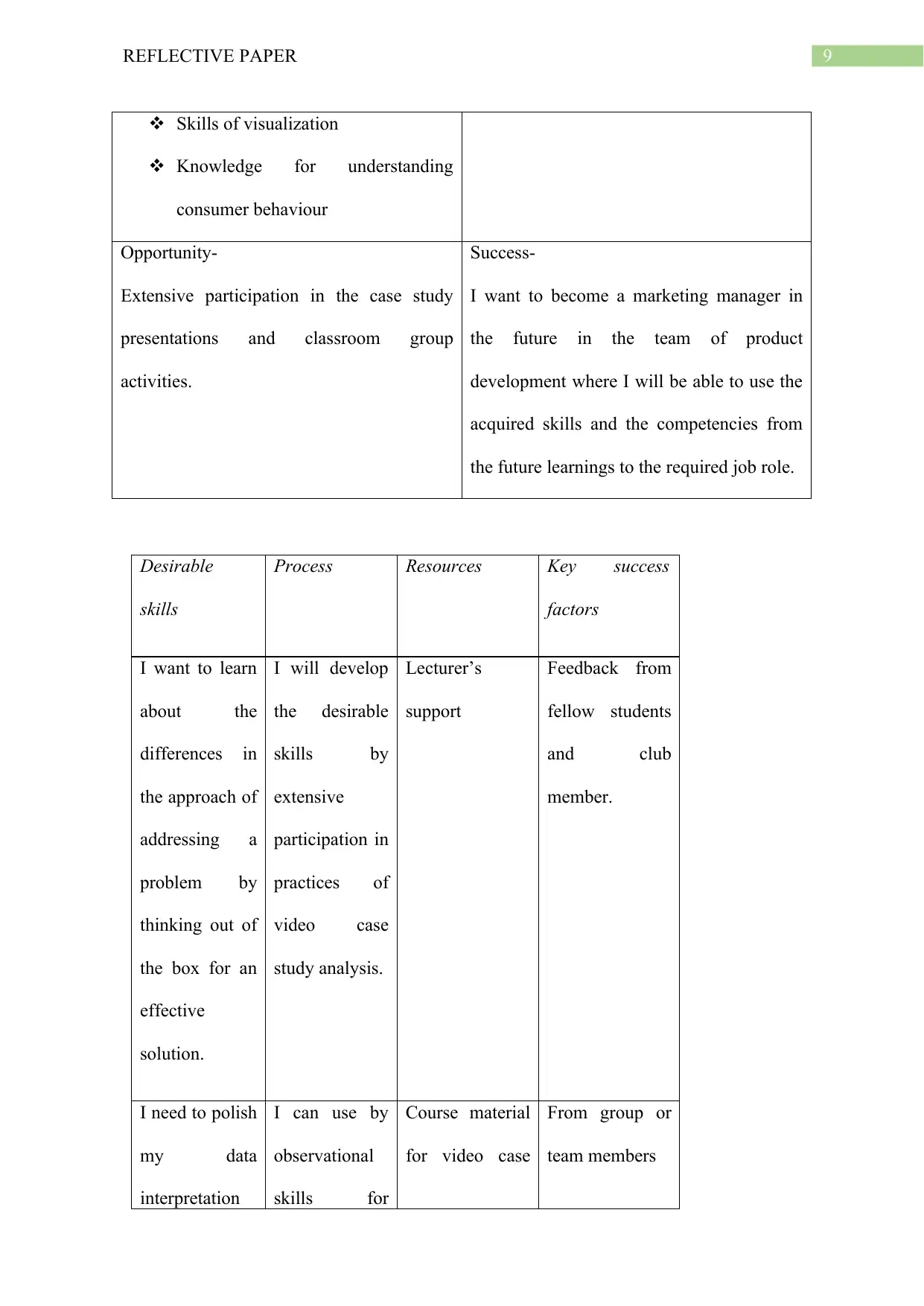
9REFLECTIVE PAPER
Skills of visualization
Knowledge for understanding
consumer behaviour
Opportunity-
Extensive participation in the case study
presentations and classroom group
activities.
Success-
I want to become a marketing manager in
the future in the team of product
development where I will be able to use the
acquired skills and the competencies from
the future learnings to the required job role.
Desirable
skills
Process Resources Key success
factors
I want to learn
about the
differences in
the approach of
addressing a
problem by
thinking out of
the box for an
effective
solution.
I will develop
the desirable
skills by
extensive
participation in
practices of
video case
study analysis.
Lecturer’s
support
Feedback from
fellow students
and club
member.
I need to polish
my data
interpretation
I can use by
observational
skills for
Course material
for video case
From group or
team members
Skills of visualization
Knowledge for understanding
consumer behaviour
Opportunity-
Extensive participation in the case study
presentations and classroom group
activities.
Success-
I want to become a marketing manager in
the future in the team of product
development where I will be able to use the
acquired skills and the competencies from
the future learnings to the required job role.
Desirable
skills
Process Resources Key success
factors
I want to learn
about the
differences in
the approach of
addressing a
problem by
thinking out of
the box for an
effective
solution.
I will develop
the desirable
skills by
extensive
participation in
practices of
video case
study analysis.
Lecturer’s
support
Feedback from
fellow students
and club
member.
I need to polish
my data
interpretation
I can use by
observational
skills for
Course material
for video case
From group or
team members
Secure Best Marks with AI Grader
Need help grading? Try our AI Grader for instant feedback on your assignments.
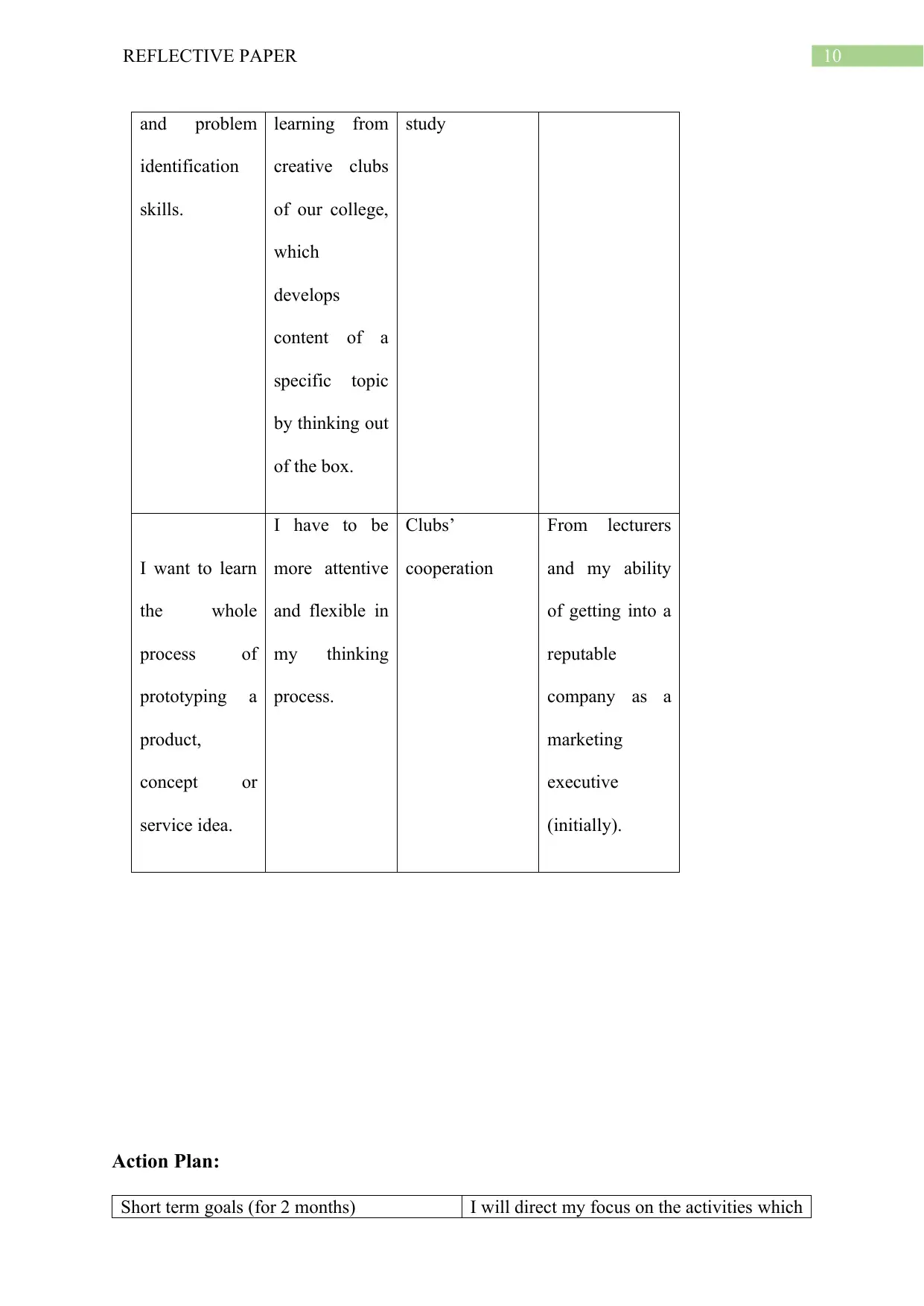
10REFLECTIVE PAPER
and problem
identification
skills.
learning from
creative clubs
of our college,
which
develops
content of a
specific topic
by thinking out
of the box.
study
I want to learn
the whole
process of
prototyping a
product,
concept or
service idea.
I have to be
more attentive
and flexible in
my thinking
process.
Clubs’
cooperation
From lecturers
and my ability
of getting into a
reputable
company as a
marketing
executive
(initially).
Action Plan:
Short term goals (for 2 months) I will direct my focus on the activities which
and problem
identification
skills.
learning from
creative clubs
of our college,
which
develops
content of a
specific topic
by thinking out
of the box.
study
I want to learn
the whole
process of
prototyping a
product,
concept or
service idea.
I have to be
more attentive
and flexible in
my thinking
process.
Clubs’
cooperation
From lecturers
and my ability
of getting into a
reputable
company as a
marketing
executive
(initially).
Action Plan:
Short term goals (for 2 months) I will direct my focus on the activities which
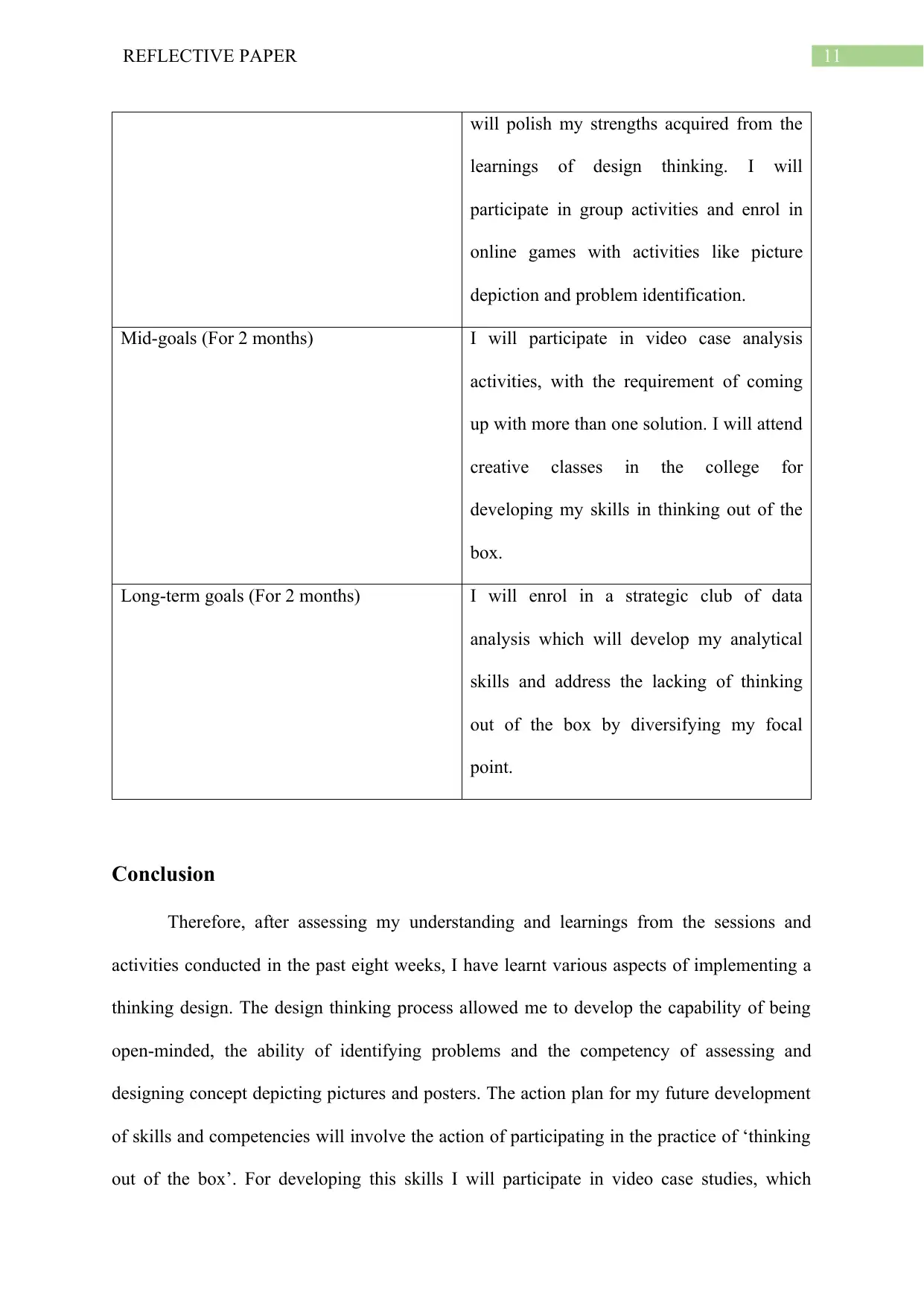
11REFLECTIVE PAPER
will polish my strengths acquired from the
learnings of design thinking. I will
participate in group activities and enrol in
online games with activities like picture
depiction and problem identification.
Mid-goals (For 2 months) I will participate in video case analysis
activities, with the requirement of coming
up with more than one solution. I will attend
creative classes in the college for
developing my skills in thinking out of the
box.
Long-term goals (For 2 months) I will enrol in a strategic club of data
analysis which will develop my analytical
skills and address the lacking of thinking
out of the box by diversifying my focal
point.
Conclusion
Therefore, after assessing my understanding and learnings from the sessions and
activities conducted in the past eight weeks, I have learnt various aspects of implementing a
thinking design. The design thinking process allowed me to develop the capability of being
open-minded, the ability of identifying problems and the competency of assessing and
designing concept depicting pictures and posters. The action plan for my future development
of skills and competencies will involve the action of participating in the practice of ‘thinking
out of the box’. For developing this skills I will participate in video case studies, which
will polish my strengths acquired from the
learnings of design thinking. I will
participate in group activities and enrol in
online games with activities like picture
depiction and problem identification.
Mid-goals (For 2 months) I will participate in video case analysis
activities, with the requirement of coming
up with more than one solution. I will attend
creative classes in the college for
developing my skills in thinking out of the
box.
Long-term goals (For 2 months) I will enrol in a strategic club of data
analysis which will develop my analytical
skills and address the lacking of thinking
out of the box by diversifying my focal
point.
Conclusion
Therefore, after assessing my understanding and learnings from the sessions and
activities conducted in the past eight weeks, I have learnt various aspects of implementing a
thinking design. The design thinking process allowed me to develop the capability of being
open-minded, the ability of identifying problems and the competency of assessing and
designing concept depicting pictures and posters. The action plan for my future development
of skills and competencies will involve the action of participating in the practice of ‘thinking
out of the box’. For developing this skills I will participate in video case studies, which
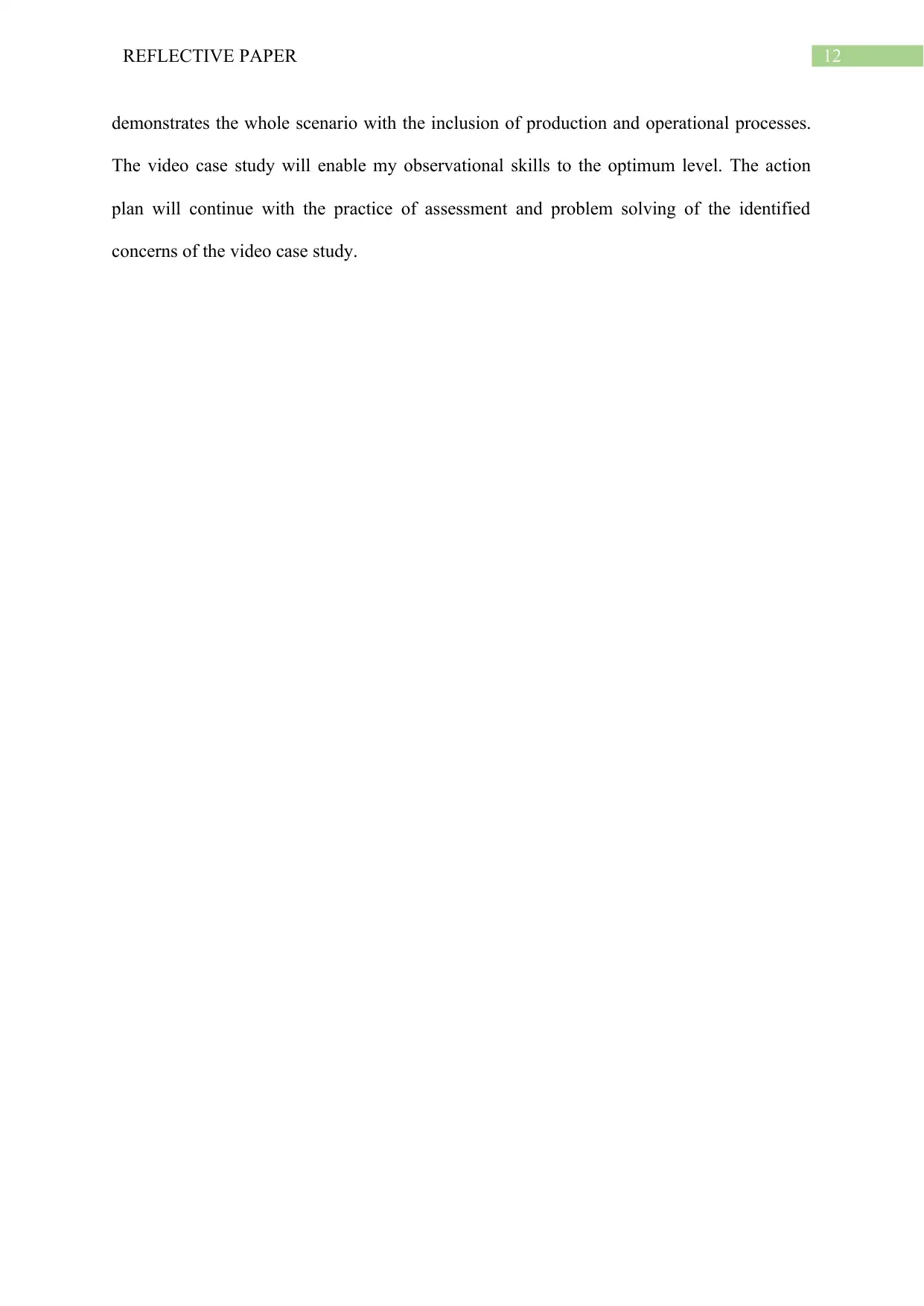
12REFLECTIVE PAPER
demonstrates the whole scenario with the inclusion of production and operational processes.
The video case study will enable my observational skills to the optimum level. The action
plan will continue with the practice of assessment and problem solving of the identified
concerns of the video case study.
demonstrates the whole scenario with the inclusion of production and operational processes.
The video case study will enable my observational skills to the optimum level. The action
plan will continue with the practice of assessment and problem solving of the identified
concerns of the video case study.
Paraphrase This Document
Need a fresh take? Get an instant paraphrase of this document with our AI Paraphraser
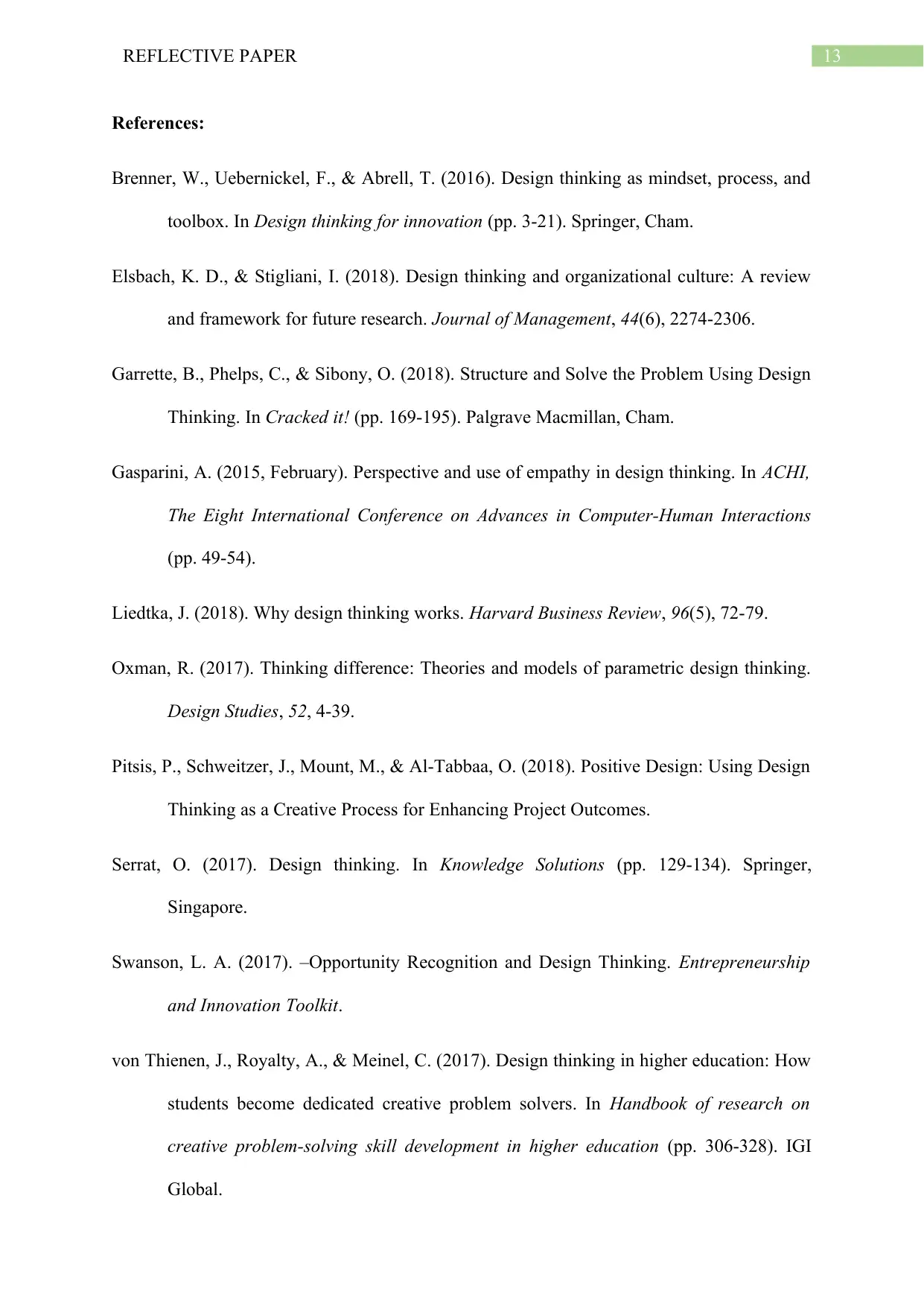
13REFLECTIVE PAPER
References:
Brenner, W., Uebernickel, F., & Abrell, T. (2016). Design thinking as mindset, process, and
toolbox. In Design thinking for innovation (pp. 3-21). Springer, Cham.
Elsbach, K. D., & Stigliani, I. (2018). Design thinking and organizational culture: A review
and framework for future research. Journal of Management, 44(6), 2274-2306.
Garrette, B., Phelps, C., & Sibony, O. (2018). Structure and Solve the Problem Using Design
Thinking. In Cracked it! (pp. 169-195). Palgrave Macmillan, Cham.
Gasparini, A. (2015, February). Perspective and use of empathy in design thinking. In ACHI,
The Eight International Conference on Advances in Computer-Human Interactions
(pp. 49-54).
Liedtka, J. (2018). Why design thinking works. Harvard Business Review, 96(5), 72-79.
Oxman, R. (2017). Thinking difference: Theories and models of parametric design thinking.
Design Studies, 52, 4-39.
Pitsis, P., Schweitzer, J., Mount, M., & Al-Tabbaa, O. (2018). Positive Design: Using Design
Thinking as a Creative Process for Enhancing Project Outcomes.
Serrat, O. (2017). Design thinking. In Knowledge Solutions (pp. 129-134). Springer,
Singapore.
Swanson, L. A. (2017). –Opportunity Recognition and Design Thinking. Entrepreneurship
and Innovation Toolkit.
von Thienen, J., Royalty, A., & Meinel, C. (2017). Design thinking in higher education: How
students become dedicated creative problem solvers. In Handbook of research on
creative problem-solving skill development in higher education (pp. 306-328). IGI
Global.
References:
Brenner, W., Uebernickel, F., & Abrell, T. (2016). Design thinking as mindset, process, and
toolbox. In Design thinking for innovation (pp. 3-21). Springer, Cham.
Elsbach, K. D., & Stigliani, I. (2018). Design thinking and organizational culture: A review
and framework for future research. Journal of Management, 44(6), 2274-2306.
Garrette, B., Phelps, C., & Sibony, O. (2018). Structure and Solve the Problem Using Design
Thinking. In Cracked it! (pp. 169-195). Palgrave Macmillan, Cham.
Gasparini, A. (2015, February). Perspective and use of empathy in design thinking. In ACHI,
The Eight International Conference on Advances in Computer-Human Interactions
(pp. 49-54).
Liedtka, J. (2018). Why design thinking works. Harvard Business Review, 96(5), 72-79.
Oxman, R. (2017). Thinking difference: Theories and models of parametric design thinking.
Design Studies, 52, 4-39.
Pitsis, P., Schweitzer, J., Mount, M., & Al-Tabbaa, O. (2018). Positive Design: Using Design
Thinking as a Creative Process for Enhancing Project Outcomes.
Serrat, O. (2017). Design thinking. In Knowledge Solutions (pp. 129-134). Springer,
Singapore.
Swanson, L. A. (2017). –Opportunity Recognition and Design Thinking. Entrepreneurship
and Innovation Toolkit.
von Thienen, J., Royalty, A., & Meinel, C. (2017). Design thinking in higher education: How
students become dedicated creative problem solvers. In Handbook of research on
creative problem-solving skill development in higher education (pp. 306-328). IGI
Global.
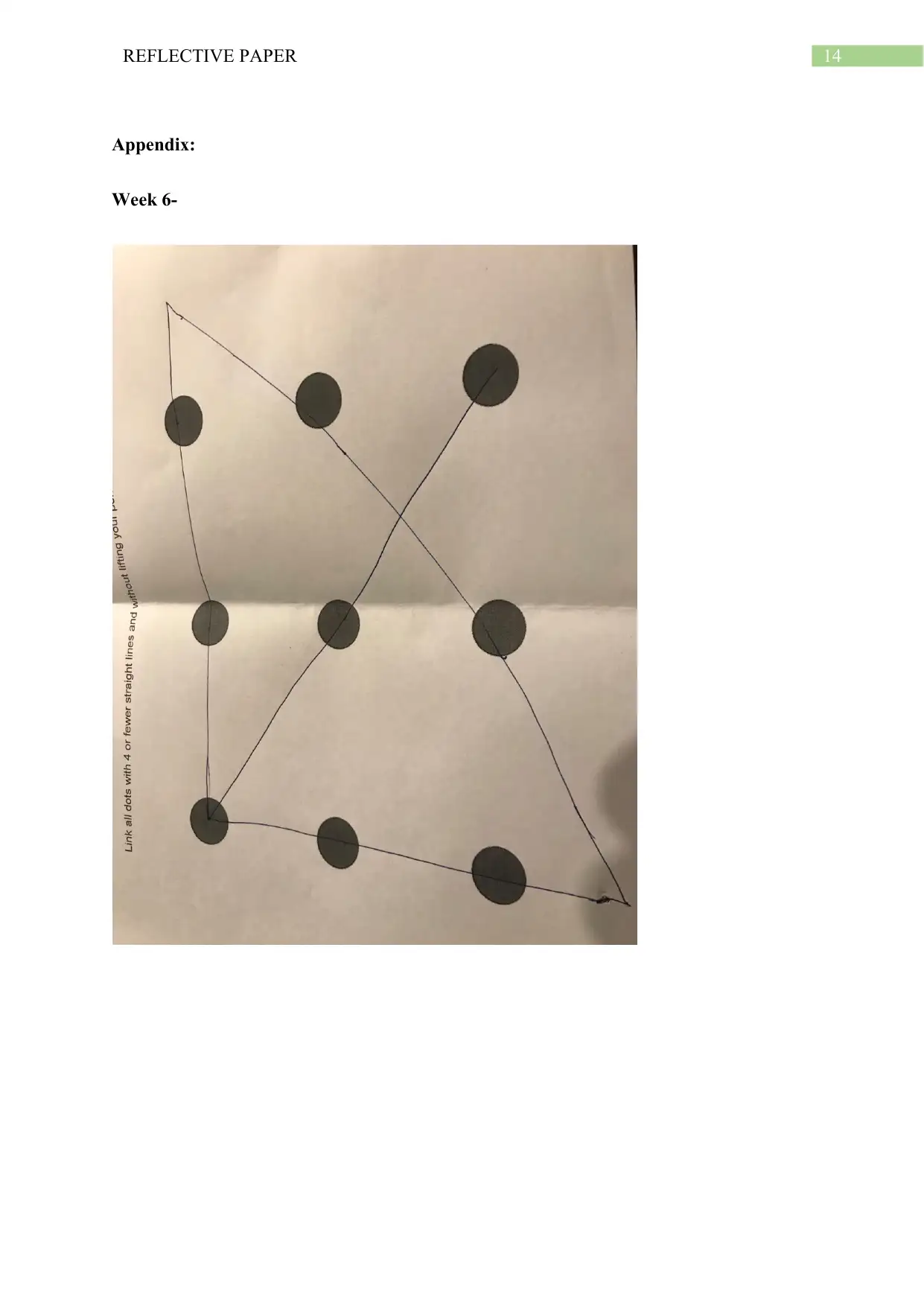
14REFLECTIVE PAPER
Appendix:
Week 6-
Appendix:
Week 6-
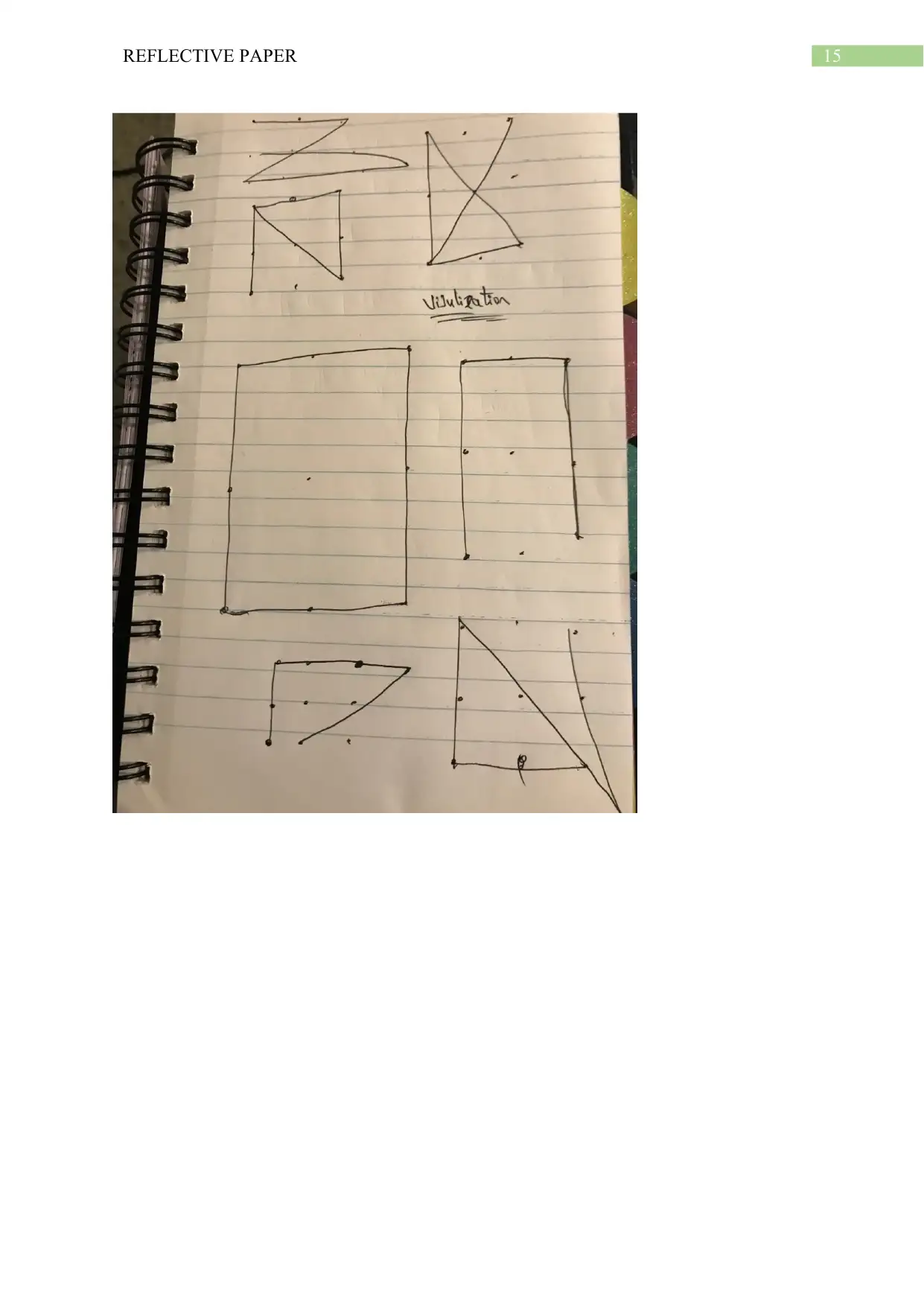
15REFLECTIVE PAPER
Secure Best Marks with AI Grader
Need help grading? Try our AI Grader for instant feedback on your assignments.
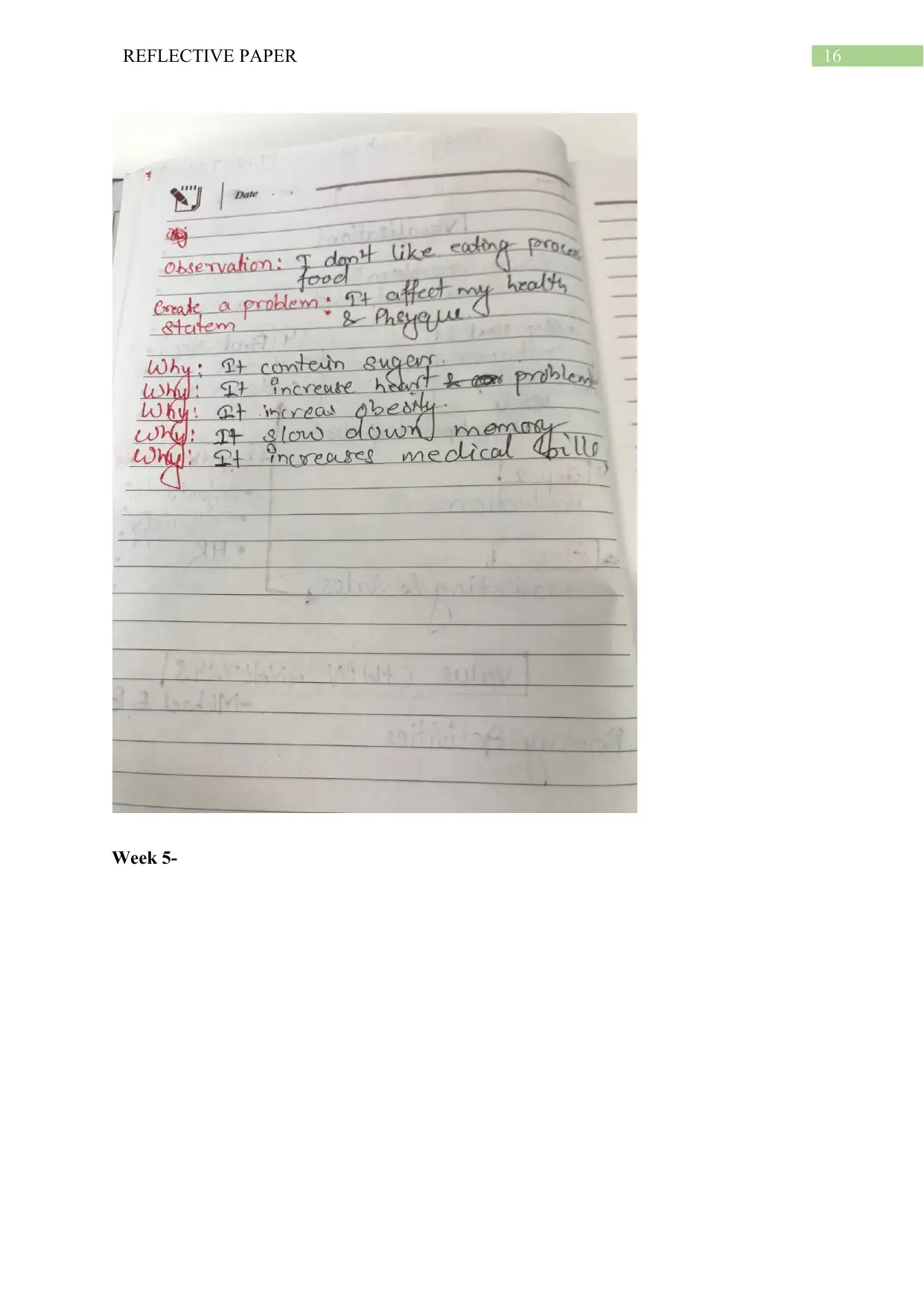
16REFLECTIVE PAPER
Week 5-
Week 5-
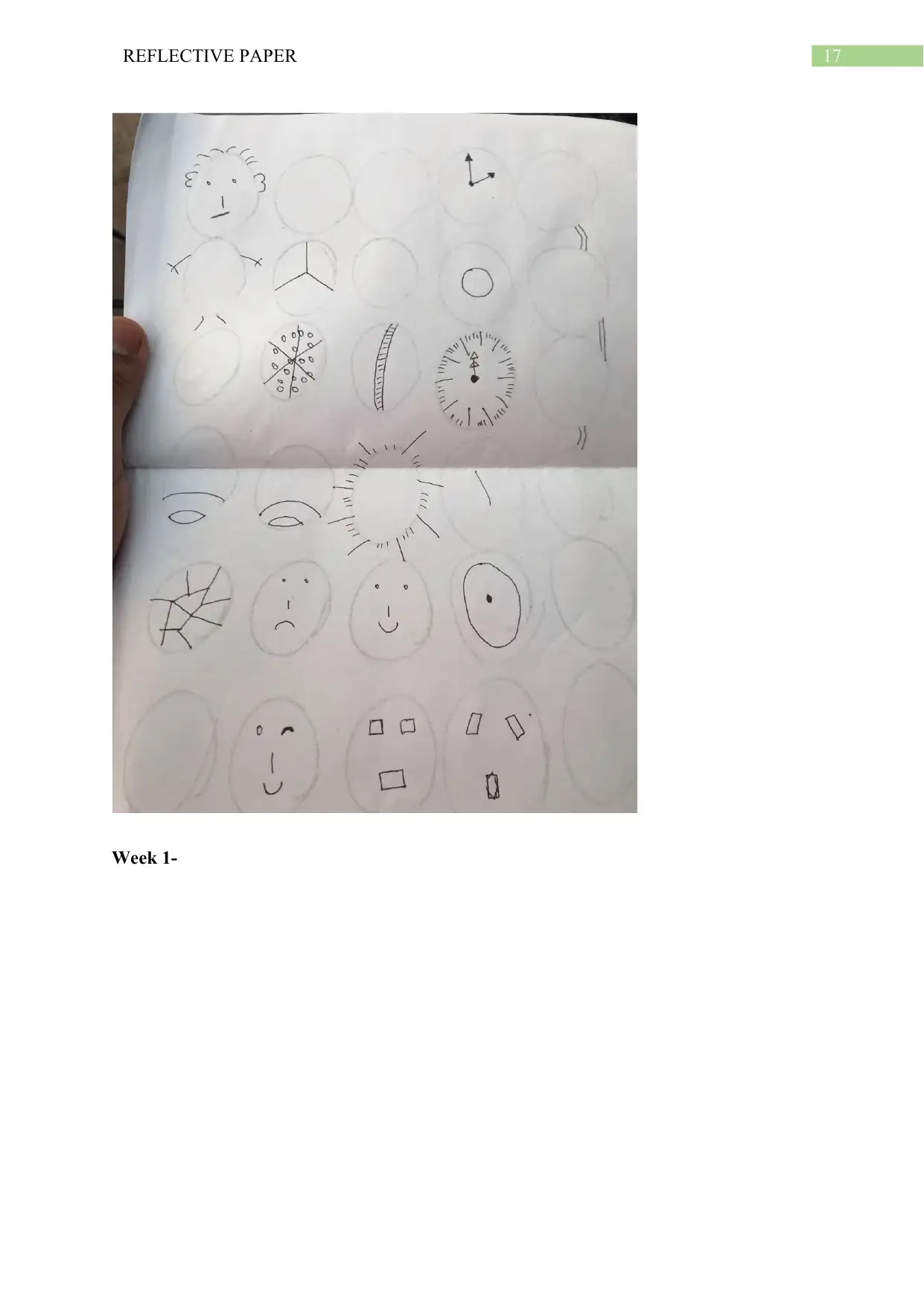
17REFLECTIVE PAPER
Week 1-
Week 1-
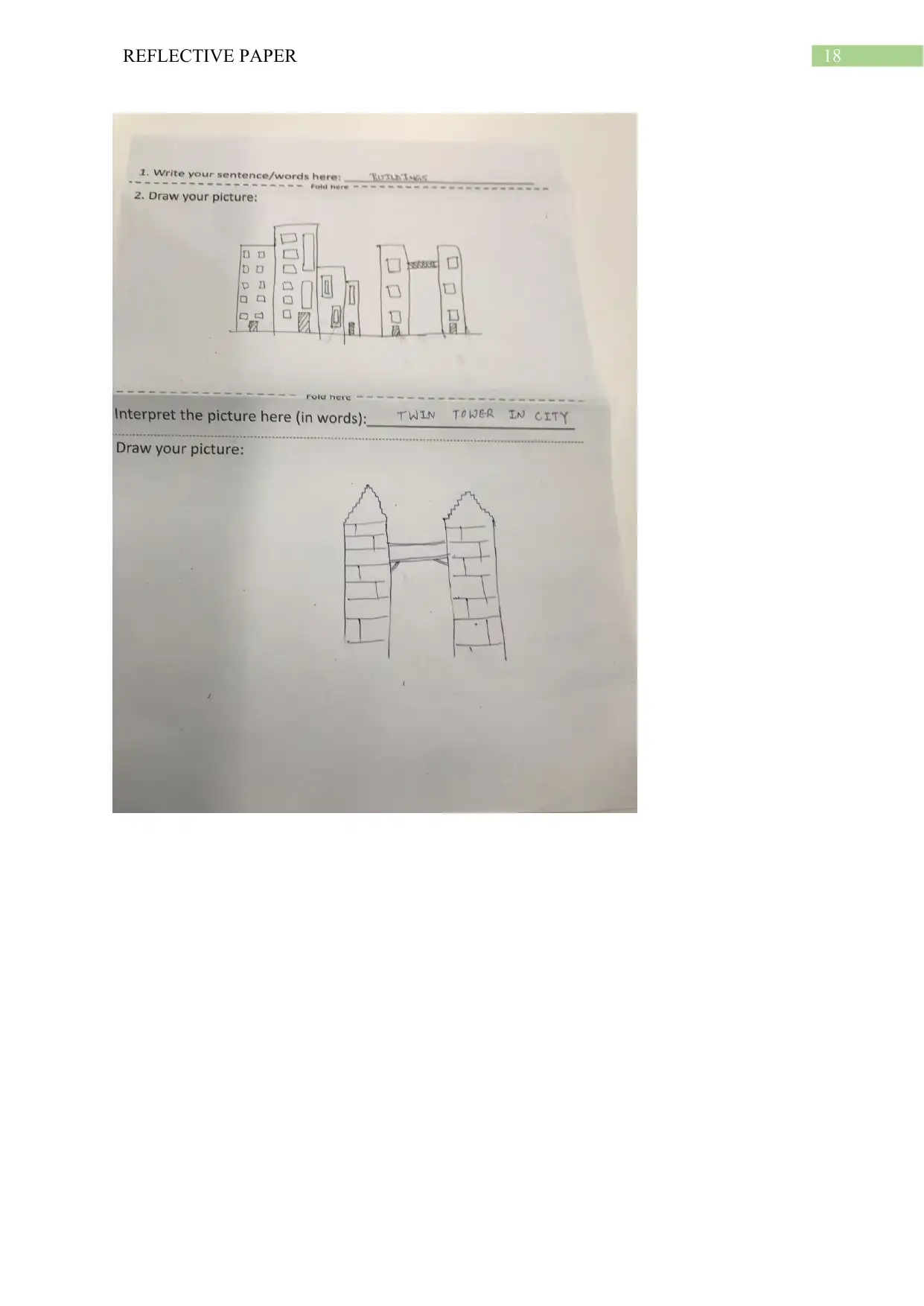
18REFLECTIVE PAPER
Paraphrase This Document
Need a fresh take? Get an instant paraphrase of this document with our AI Paraphraser

19REFLECTIVE PAPER
1 out of 20
Related Documents
Your All-in-One AI-Powered Toolkit for Academic Success.
+13062052269
info@desklib.com
Available 24*7 on WhatsApp / Email
![[object Object]](/_next/static/media/star-bottom.7253800d.svg)
Unlock your academic potential
© 2024 | Zucol Services PVT LTD | All rights reserved.




